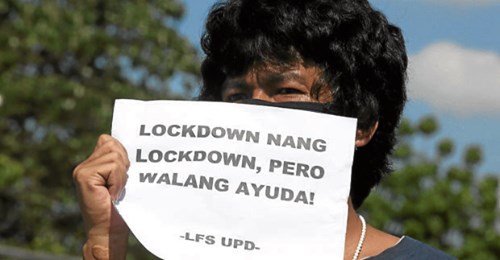
A member of a progressive movement protests the continued lockdown in some parts of the country and the government’s failure to provide adequate aid.
MANILA, Philippines — The unemployment rate worsened to 8.1 percent in August as many business establishments in Metro Manila were forced to close by the lockdown meant to contain the spread of COVID-19 and as thousands of fresh college graduates entered the labor market for the first time, the government reported on Thursday.
The highest since the 8.7 percent in April this year, the August rate translated to 3.88 million Filipinos without work, up from 3.07 million in July, data from the Philippine Statistics Authority (PSA) showed. The high joblessness last April similarly resulted from the return of the National Capital Region to the strict enhanced community quarantine (ECQ).
Socioeconomic Planning Secretary Karl Kendrick Chua said at a Palace briefing on Thursday that job creation had been dependent on the quarantine restrictions being imposed by the government, noting that lockdowns temporarily stopped jobs while gradual easings resumed employment generation.
National Statistician Dennis Mapa pointed out that the gradual improvement in unemployment paused whenever ECQ was imposed, citing the cases in April 2020, April this year, and last August.
“In terms of job creation, we’ve seen that it is correlated with the degree or restrictiveness of our quarantines,” added Chua, who is also the director-general of the National Economic Development Authority (Neda).
Citing Neda data, he said 69 percent of the country’s economy remained either under general community quarantine with heightened restrictions or, in the case of Metro Manila, alert level 4. This translated to 23.3 million workers affected by work disruptions.
New approach
However, Chua said the change in tack to granular lockdowns following declining daily infections and increasing vaccination would hopefully return the jobs lost due to the pandemic.
“The good news is that with the cases going down, we are seeing that starting October, we will have more opportunity to further bring down our quarantine classification. That is what we need to do alongside vaccination to hasten the reopening of our economy,” he said.
This supported calls of the private sector to ease quarantine restrictions this fourth quarter of 2021 to allow businesses to recover and the overall economy to improve.
Last Wednesday, businesses appealed to the government to place Metro Manila under the more relaxed alert level 3 in the last three months of the year to allow establishments to accept more customers.
Chua added that economic growth was resuming in the Philippines, but its sustainability would depend on several actions being taken in dealing with the COVID-19 pandemic.
Measures needed
He said that even if the number of cases in September had gone down, measures should remain in place to prevent surges.
“It doesn’t mean we are already safe [from surges], it means our strategy of balancing the risk between [matters related to] COVID and non-COVID is working. So we continue to use our strategy to use granular lockdowns and more targeted approaches to control COVID, especially in spaces with close contact [activities] and poor ventilation,” Chua said.
The secretary said lockdowns covering large swathes of the country would no longer work and only add to more people going hungry and sick.
“The real solution is to implement minimum health standards and focus our strategies in highest risk areas. This worked during the three times we were under (ECQ),” he added.
Chua said the government should be able to learn from the experiences in the alert level system with granular lockdowns being piloted in Metro Manila to see if these could be duplicated in other parts of the country.
“We can’t go back to whole-country or whole-region lockdowns anymore, we need to learn to live with this virus,” he said.
Strategy
Chua recommended that for the strong recovery to be maintained, growth rates of 4 percent to 5 percent in 2021 and 7 percent to 9 percent in 2022 should be ensured and this could be done by accelerating the vaccination of all adult Filipinos to reach 70 million by end of 2021, expanding vaccination sites, removing artificial barriers and using technology to reduce wait and processing times.
The continuance of the prevent-detect-isolate-treat-reintegrate (PDITR) strategy would enable the government to manage risks better and reopen the economy safely, Chua said. This would allow family activities and face-to-face classes to resume, with localized lockdowns imposed in highest risk areas.
“Remember [that] the most restrictive community quarantines will only postpone the surge. What will reduce the surge is the PDITR,” he added.
Chua said the recovery program should continue to be implemented through the timely use of what remains of the 2021 budget, and reprioritizing the budget for the most important programs.
The executive branch should also work with Congress to refine the 2022 budget allocations and future budgets to address deficiencies in investments in physical and human capital to close the gap faster, he added.
Chua said Neda was projecting P41.3 trillion as the cost of COVID-19 and quarantines to the Philippine economy from 2020 to the next one to four decades, of which P4.3 trillion would be in 2020 and P37 trillion in the next to 10 to 40 years.
READ NEXT
Read more: https://newsinfo.inquirer.net/1495413/unemployed-swell-to-3-9m-in-august-due-to-lockdowns#ixzz77zuCjpOR
Follow us: @inquirerdotnet on Twitter | inquirerdotnet on Facebook